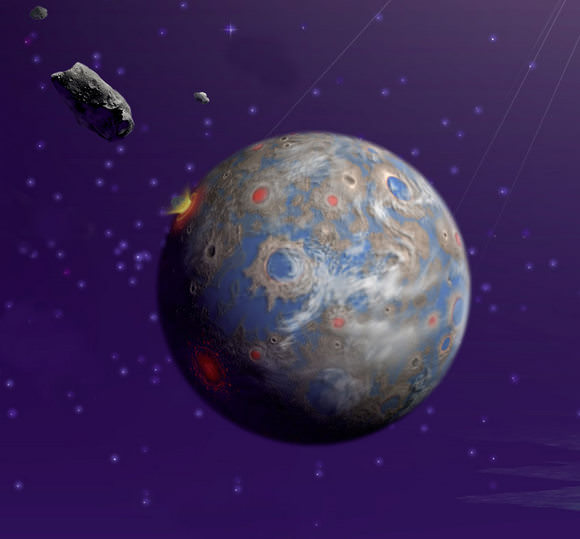Celestial impacts can bring life as well as wipe it out, say the authors of a new study out of the University of Colorado at Boulder.
A case in point: the bombardment of Earth nearly 4 billion years ago by asteroids as large as Kansas would not have had the firepower to extinguish potential early life on the planet and may even have given it a boost.
In a new paper in the journal Nature, Oleg Abramov and Stephen Mojzsis report on their study of impact evidence from lunar samples, meteorites and the pockmarked surfaces of the inner planets. The evidence paints a picture of a violent environment in the solar system during the Hadean Eon 4.5 to 3.8 billion years ago, particularly through a cataclysmic event known as the Late Heavy Bombardment about 3.9 billion years ago.
Although many believe the bombardment would have sterilized Earth, the new study shows it would have melted only a fraction of Earth’s crust, and that microbes could well have survived in subsurface habitats, insulated from the destruction.
“These new results push back the possible beginnings of life on Earth to well before the bombardment period 3.9 billion years ago,” Abramov said. “It opens up the possibility that life emerged as far back as 4.4 billion years ago, about the time the first oceans are thought to have formed.”
Because physical evidence of Earth’s early bombardment has been erased by weathering and plate tectonics over the eons, the researchers used data from Apollo moon rocks, impact records from the moon, Mars and Mercury, and previous theoretical studies to build three-dimensional computer models that replicate the bombardment. Abramov and Mojzsis plugged in asteroid size, frequency and distribution estimates into their simulations to chart the damage to the Earth during the Late Heavy Bombardment, which is thought to have lasted for 20 million to 200 million years.
The 3-D models allowed Abramov and Mojzsis to monitor temperatures beneath individual craters to assess heating and cooling of the crust following large impacts in order to evaluate habitability. The study indicated that less than 25 percent of Earth’s crust would have melted during such a bombardment.
The CU-Boulder researchers even cranked up the intensity of the asteroid barrage in their simulations by 10-fold — an event that could have vaporized Earth’s oceans. “Even under the most extreme conditions we imposed, Earth would not have been completely sterilized by the bombardment,” said Abramov.
Instead, hydrothermal vents may have provided sanctuaries for extreme, heat-loving microbes known as “hyperthermophilic bacteria” following bombardments, said Mojzsis. Even if life had not emerged by 3.9 billion years ago, such underground havens could still have provided a “crucible” for life’s origin on Earth, Mojzsis said.
Geologic evidence suggests that life on Earth was present at least 3.83 billion years ago, said Mojzsis. “So it is not unreasonable to suggest there was life on Earth before 3.9 billion years ago. We know from the geochemical record that our planet was eminently habitable by that time, and this new study sews up a major problem in origins of life studies by sweeping away the necessity for multiple origins of life on Earth.”
The results also support the potential for microbial life on other planets like Mars and perhaps even rocky, Earth-like planets in other solar systems that may have been resurfaced by impacts, said Abramov.
Source: Eurekalert


You said: “Late Heavy Bombardment about 3.9 million years ago”. I think you meant “billion”.
Thanks!
Cool discovery!